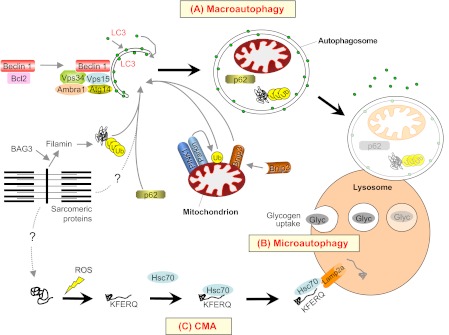Fig. 2.
Macroautophagy, microautophagy and chaperone-mediated autophagy (CMA), and their contribution to protein degradation and organelle removal in skeletal muscle. (A) Macroautophagy is triggered by the activation of a regulatory complex (containing Vps34, Beclin 1, Vps15, Ambra1 and Atg14) that induces LC3 recruitment to the nascent autophagosome (isolation membrane). Selective removal of mitochondria (mitophagy; a specific form of macroautophagy) requires the PINK1-parkin complex and Bnip3 factors. Proteins that are committed for lysosomal degradation (including BAG3 and filamin, shown here) are labeled by polyubiquitin chains and delivered to the autophagosome by the p62 scaffold protein. (B) Microautophagy involves the direct engulfment of small portions of cytoplasm into lysosomes. Glycogen (Glyc) is reportedly taken up and broken down by microautophagy in skeletal muscle. (C) In CMA, proteins that are damaged by different agents, such as reactive oxygen species (ROS), expose a specific amino acid sequence (the KFERQ motif) that is recognized by the Hsc70 chaperone, which in turn delivers them to the lysosome via interaction with Lamp2a receptors. Dotted lines depict pathways whose molecular mechanisms and roles in adult skeletal muscle have not yet been fully defined.

